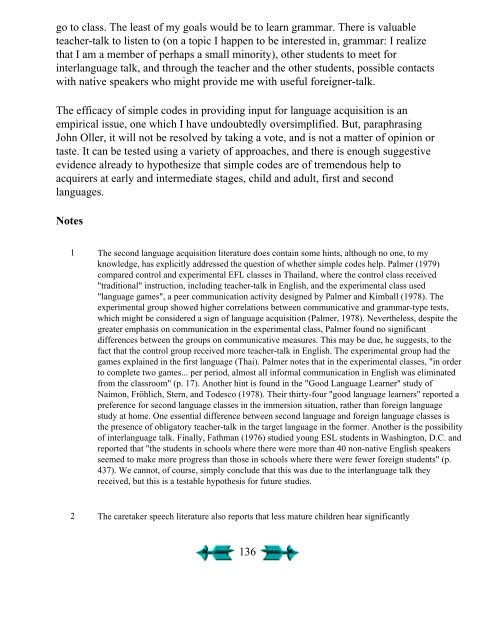Second Language Acquisition and Second ... - Stephen Krashen
Second Language Acquisition and Second ... - Stephen Krashen
Second Language Acquisition and Second ... - Stephen Krashen
You also want an ePaper? Increase the reach of your titles
YUMPU automatically turns print PDFs into web optimized ePapers that Google loves.
go to class. The least of my goals would be to learn grammar. There is valuable<br />
teacher-talk to listen to (on a topic I happen to be interested in, grammar: I realize<br />
that I am a member of perhaps a small minority), other students to meet for<br />
interlanguage talk, <strong>and</strong> through the teacher <strong>and</strong> the other students, possible contacts<br />
with native speakers who might provide me with useful foreigner-talk.<br />
The efficacy of simple codes in providing input for language acquisition is an<br />
empirical issue, one which I have undoubtedly oversimplified. But, paraphrasing<br />
John Oller, it will not be resolved by taking a vote, <strong>and</strong> is not a matter of opinion or<br />
taste. It can be tested using a variety of approaches, <strong>and</strong> there is enough suggestive<br />
evidence already to hypothesize that simple codes are of tremendous help to<br />
acquirers at early <strong>and</strong> intermediate stages, child <strong>and</strong> adult, first <strong>and</strong> second<br />
languages.<br />
Notes<br />
1 The second language acquisition literature does contain some hints, although no one, to my<br />
knowledge, has explicitly addressed the question of whether simple codes help. Palmer (1979)<br />
compared control <strong>and</strong> experimental EFL classes in Thail<strong>and</strong>, where the control class received<br />
"traditional" instruction, including teacher-talk in English, <strong>and</strong> the experimental class used<br />
"language games", a peer communication activity designed by Palmer <strong>and</strong> Kimball (1978). The<br />
experimental group showed higher correlations between communicative <strong>and</strong> grammar-type tests,<br />
which might be considered a sign of language acquisition (Palmer, 1978). Nevertheless, despite the<br />
greater emphasis on communication in the experimental class, Palmer found no significant<br />
differences between the groups on communicative measures. This may be due, he suggests, to the<br />
fact that the control group received more teacher-talk in English. The experimental group had the<br />
games explained in the first language (Thai). Palmer notes that in the experimental classes, "in order<br />
to complete two games... per period, almost all informal communication in English was eliminated<br />
from the classroom" (p. 17). Another hint is found in the "Good <strong>Language</strong> Learner" study of<br />
Naimon, Fröhlich, Stern, <strong>and</strong> Todesco (1978). Their thirty-four "good language learners" reported a<br />
preference for second language classes in the immersion situation, rather than foreign language<br />
study at home. One essential difference between second language <strong>and</strong> foreign language classes is<br />
the presence of obligatory teacher-talk in the target language in the former. Another is the possibility<br />
of interlanguage talk. Finally, Fathman (1976) studied young ESL students in Washington, D.C. <strong>and</strong><br />
reported that "the students in schools where there were more than 40 non-native English speakers<br />
seemed to make more progress than those in schools where there were fewer foreign students" (p.<br />
437). We cannot, of course, simply conclude that this was due to the interlanguage talk they<br />
received, but this is a testable hypothesis for future studies.<br />
2 The caretaker speech literature also reports that less mature children hear significantly<br />
136











